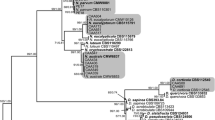Abstract
Chrysoporthe cubensis is an important pathogen of commercially planted Eucalyptus species (Myrtaceae) in tropical and subtropical parts of the world where these trees are planted as non-natives. Although the majority of Eucalyptus spp. are native to Australia, Chr. cubensis is not common there and has been reported only once from naturally growing Eucalyptus marginata in Western Australia. Chr. cubensis is able to infect hosts in the Myrtaceae and Melastomataceae other than Eucalyptus, but has not been found on hosts other than Eucalyptus in Australia. Recently, fruiting structures resembling those of Chr. cubensis were discovered on Tibouchina heteromalla, planted as a non-native in the Botanical Gardens in Cairns, northern Queensland. These fruiting structures and resulting isolates were characterised as Chr. cubensis in this study. Pathogenicity studies found that Corymbia spp., including commercially important spotted gum, are susceptible along with E. pilularis and E. dunnii. The discovery of Chr. cubensis on a non-native plant in the northern part of Australia is important as it might imply that the pathogen has been introduced into the country and pose a significant threat to native Eucalyptus forests. Alternatively, this fungus might occur naturally in the area on hosts other than Tibouchina, possibly Eucalyptus or related species, and that Australia forms part of its native range.
Similar content being viewed by others
References
Andjic V, Barber PA, Carnegie AJ, Pegg GS, Hardy GE, Wingfield MJ, Burgess TI (2007) Kirramyces viscidus sp. nov., a new eucalypt pathogen from tropical Australia closely related to the serious leaf pathogen, Kirramyces destructans. Australasian Plant Pathology 36, 478–487. doi:10.1071/AP07054
Carnegie AJ (2007) Forest health condition in New South Wales, Australia, 1996-2005. II. Fungal damage recorded in eucalypt plantations during forest health surveys and their management. Australasian Plant Pathology 36, 225–239. doi:10.1071/AP07021
Davison EM, Coates DJ (1991) Identification of Cryphonectria cubensis and Endothia gyrosa from eucalypts in Western Australia using isozyme analysis. Australasian Plant Pathology 20, 157–160. doi:10.1071/ APP9910157
Desprez-Loustau ML, Marcais B, Nageleisen LM, Piou D, Vannini A (2006) Interactive effects of drought and pathogens in forest trees. Annals of Forest Science 63, 597–612. doi:10.1051/forest:2006040
Gavran M, Parsons M (2008) ‘National plantation inventory 2008 update.’ (National Forest Inventory, Bureau of Rural Sciences: Canberra)
Glass NL, Donaldson GC (1995) Development of primer sets designed for use with the PCR to amplify conserved genes from filamentous ascomycetes. Applied and Environmental Microbiology 61, 1323–1330.
Gryzenhout M, Myburg H, van der Merwe NA, Wingfield BD, Wingfield MJ (2004) Chrysoporthe, a new genus to accommodate Cryphonectria cubensis. Studies in Mycology 50, 119–142.
Gryzenhout M, Myburg H, Wingfield BD, Montenegro F, Wingfield MJ (2005) Chrysoporthe doradensis sp. nov. pathogenic to Eucalyptus in Ecuador. Fungal Diversity 20, 39–57.
Gryzenhout M, Rodas CA, Portales JM, Clegg P, Wingfield BD, Wingfield MJ (2006) Novel hosts of the Eucalyptus canker pathogen Chrysoporthe cubensis and a new Chrysoporthe species from Colombia. Mycological Research 110, 833–845. doi:10.1016/j.mycres.2006.02.010
Gryzenhout M, Wingfield BD, Wingfield MJ (2009) ‘Taxonomy, phylogeny, and ecology of bark-infecting and tree-killing fungi in the Cryphonectriaceae.’ (APS Press: St Paul, MN)
Heath RN, Roux J, Gryzenhout M, Carnegie AJ, Smith IW, Wingfield MJ (2007) Holocryphia eucalypti on Tibouchina urvilleana in Australia. Australasian Plant Pathology 36, 560–564. doi:10.1071/AP07059
Heath RN, Roux J, Slippers B, Drenth A, Pennycook A, Wingfield MJ, Wingfield BD (2009) Occurrence and pathogenicity of Neofusicoccum parvum and N. mangiferae on ornamental Tibouchina species. Forest Pathology in press.
Hodges CS, Alfenas AC, Ferreira FA (1986) The conspecificity of Cryphonectria cubensis and Endothia eugeniae. Mycologia 78, 343–350. doi:10.2307/3793037
Myburg H, Gryzenhout M, Heath R, Roux J, Wingfield BD, Wingfield MJ (2002a) Cryphonectria canker on Tibouchina in South Africa. Mycological Research 106, 1299–1306. doi:10.1017/S0953756202 00669X
Myburg H, Gryzenhout M, Wingfield BD, Wingfield MJ (2002b) b-tubulin and Histone H3 gene sequences distinguish Cryphonectria cubensis from South Africa, Asia and South America. Canadian Journal of Botany 80, 590–596. doi:10.1139/b02-039
Myburg H, Gryzenhout M, Wingfield BD, Wingfield MJ (2003) Conspecificity of Endothia eugeniae and Cryphonectria cubensis: a re-evaluation based on morphology and DNA sequence data. Mycoscience 104, 187–196.
Pegg GS, O’Dwyer C, Carnegie AJ, Wingfield MJ, Drenth A (2008) Quambalaria species associated with plantation and native eucalypts in Australia. Plant Pathology 57, 702–714. doi:10.1111/j.1365-3059.2008.01840.x
Rodas CA, Gryzenhout M, Myburg H, Wingfield BD, Wingfield MJ (2005) Discovery of the Eucalyptus canker pathogen Chrysoporthe cubensis on native Miconia (Melastomataceae) in Colombia. Plant Pathology 54, 460–470. doi:10.1111/j.1365-3059.2005.01223.x
Slippers B, Stenlid J, Wingfield MJ (2005) Emerging pathogens: fungal host jumps following anthropogenic introduction. Trends in Ecology & Evolution 20, 420–421. doi:10.1016/j.tree.2005.05.002
Slippers B, Burgess T, Pavlic D, Ahumada R, Maleme H, Mohali S, Rodas C, Wingfield MJ (2009) A diverse assemblage of Botryosphaeriaceae infect Eucalyptus in native and non-native environments. Southern Forests 71, 101–110.
Van Wyk M, Pegg GS, Lawson S, Wingfield MJ (2007) Ceratocystis atrox sp. nov. associated with Phoracantha acanthocera infestations on Eucalyptus grandis in Australia. Australasian Plant Pathology 36, 407–414. doi:10.1071/AP07042
Wardlaw TJ (1999) Endothia gyrosa associated with severe stem cankers on plantation-grown Eucalyptus nitens in Tasmania, Australia. European Journal of Forest Pathology 29, 199–208. doi:10.1046/j.1439-0329. 1999.00143.x
Wingfield MJ, Rodas C, Myburg H, Venter M, Wright J, Wingfield BD (2001) Cryphonectria canker on Tibouchina in Colombia. Forest Pathology 31, 297–306. doi:10.1046/j.1439-0329.2001.00248.x
Yuan ZQ, Mohammed C (2001) Lesion development in stems of rough- and smooth-barked Eucalyptus nitens following artificial inoculations with canker fungi. Forest Pathology 31, 149–161. doi:10.1046/j.1439-0329.2001.00227.x
Author information
Authors and Affiliations
Corresponding author
Rights and permissions
About this article
Cite this article
Pegg, G.S., Gryzenhout, M., O’Dwyer, C. et al. The Eucalyptus canker pathogen Chrysoporthe cubensis discovered in eastern Australia. Australasian Plant Pathol. 39, 343–349 (2010). https://doi.org/10.1071/AP10004
Received:
Accepted:
Issue Date:
DOI: https://doi.org/10.1071/AP10004




